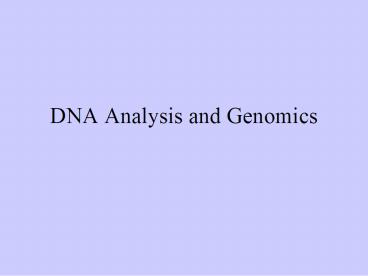DNA Analysis and Genomics - PowerPoint PPT Presentation
1 / 15
Title:
DNA Analysis and Genomics
Description:
We can use gel electrophoresis to sort the DNA fragments by size. ... Samples of DNA molecules are put into wells ... The DNA molecules are negatively charged. ... – PowerPoint PPT presentation
Number of Views:57
Avg rating:3.0/5.0
Title: DNA Analysis and Genomics
1
DNA Analysis and Genomics
2
Genomics
- Genomics studying whole sets of genes and their
interactions. - We can separate molecules on the basis of charge,
size, and other physical properties. - For DNA, size is the basis for the separation.
3
Restriction Fragment Analysis
- Analysis of restriction fragments shows certain
differences in the nucleotide sequences of DNA. - We can use gel electrophoresis to sort the DNA
fragments by size. - Two different alleles for a trait will have
slightly different nucleotide sequences. - Thus they will have slightly different
restriction sites and produce different
restriction fragments.
4
Gel Electrophoresis
- Samples of DNA molecules are put into wells or
cuts in a gel material called agarose. - These samples have been cut with restriction
enzymes and therefore are of various lengths. - The DNA molecules are negatively charged.
- The gel chamber has a positive and negative end
based on the current flow through the devise. - The molecules migrate toward the positive end.
- This produces bands of DNA down the length of the
gel.
5
RFLPs
- Restriction fragment length polymorphisms are
differences in the DNA sequence on homologous
chromosomes that can result in different banding
patterns. - RFLPs served as a basis for starting point for
mapping the genome.
6
The Procedure
- Here is a gel.
- The wells are empty.
- We will use a micropipet to pipet DNA into the
wells.
7
The DNA
- Here are examples of microtubes which contain
DNA, - Always keep the lid closed when not in use and
never lay them down on the counter you will
contaminate the counter and the DNA.
8
Loading the Gels
- The micropipet contains a small amount of DNA
which is carefully loaded into each well. - Always number the DNA samples so that you know
which sample is in which well.
9
Wells are Loaded
- Blue dye has been added to the DNA to make it
visible. - Here is an example of wells that contain DNA
samples.
10
Running the Gels
- The loaded agarose is put into the chamber and
the power source is turned on. - The DNA will begin to migrate down the gel.
11
DNA Migration
- After some time, the bands of DNA can be seen
moving away from the wells.
12
Staining
- Once the DNA has migrated a sufficient amount to
see different banding patterns, the gel must be
stained for easier viewing.
13
Viewing
- A light box makes viewing the band much easier.
- Never place the gel directly on the box. Use
plastic wrap to protect the light box.
14
Results
- Here is an example of what a stained gel looks
like. - Notice the darker blue bands at different places
on the gel. - Each band represents a fragment of a particular
size.
15
Analysis
- The distance the DNA migrates can be measured and
used to determine the size of the fragment. - The size of the fragment will be measured in base
pairs or bps.































